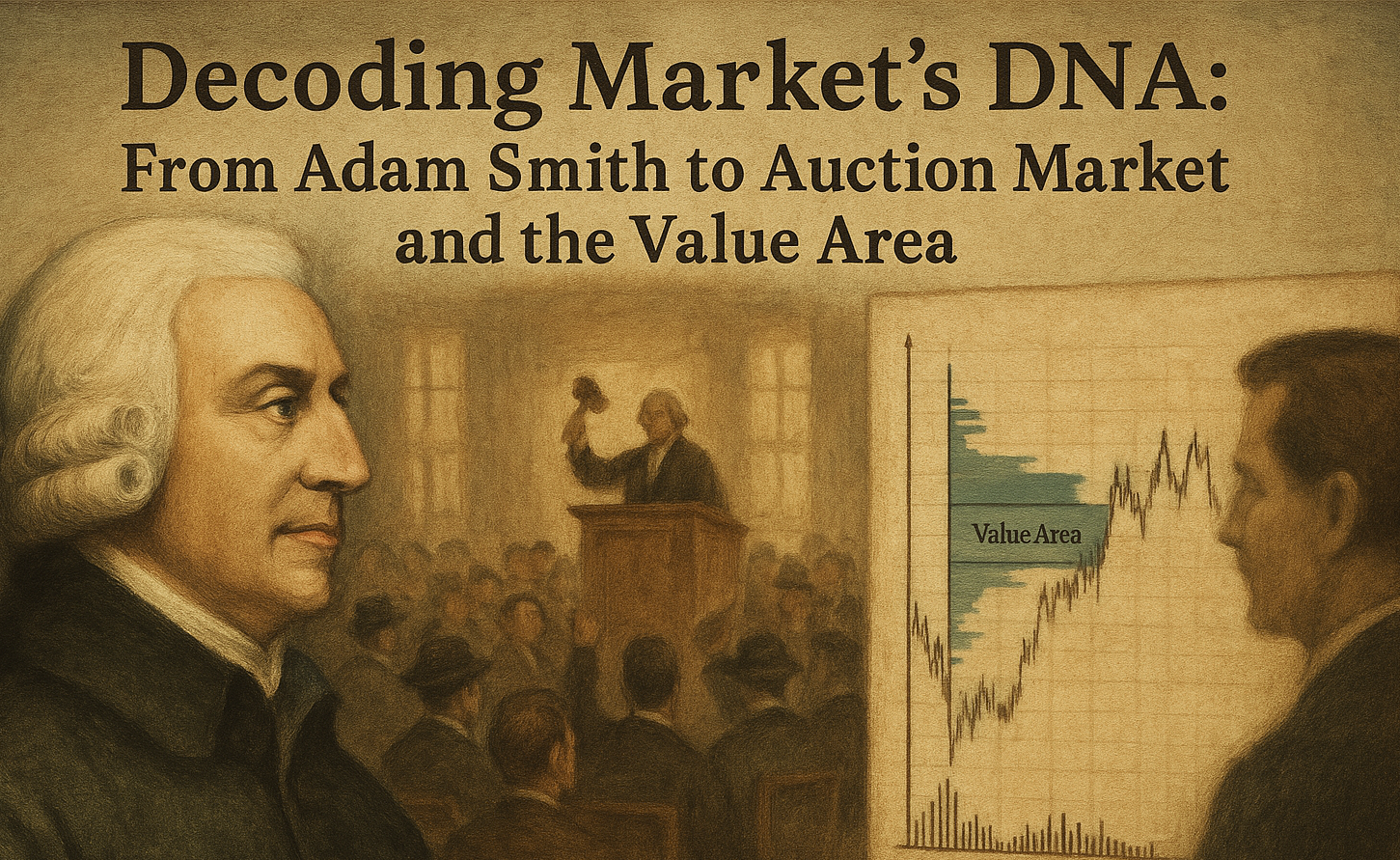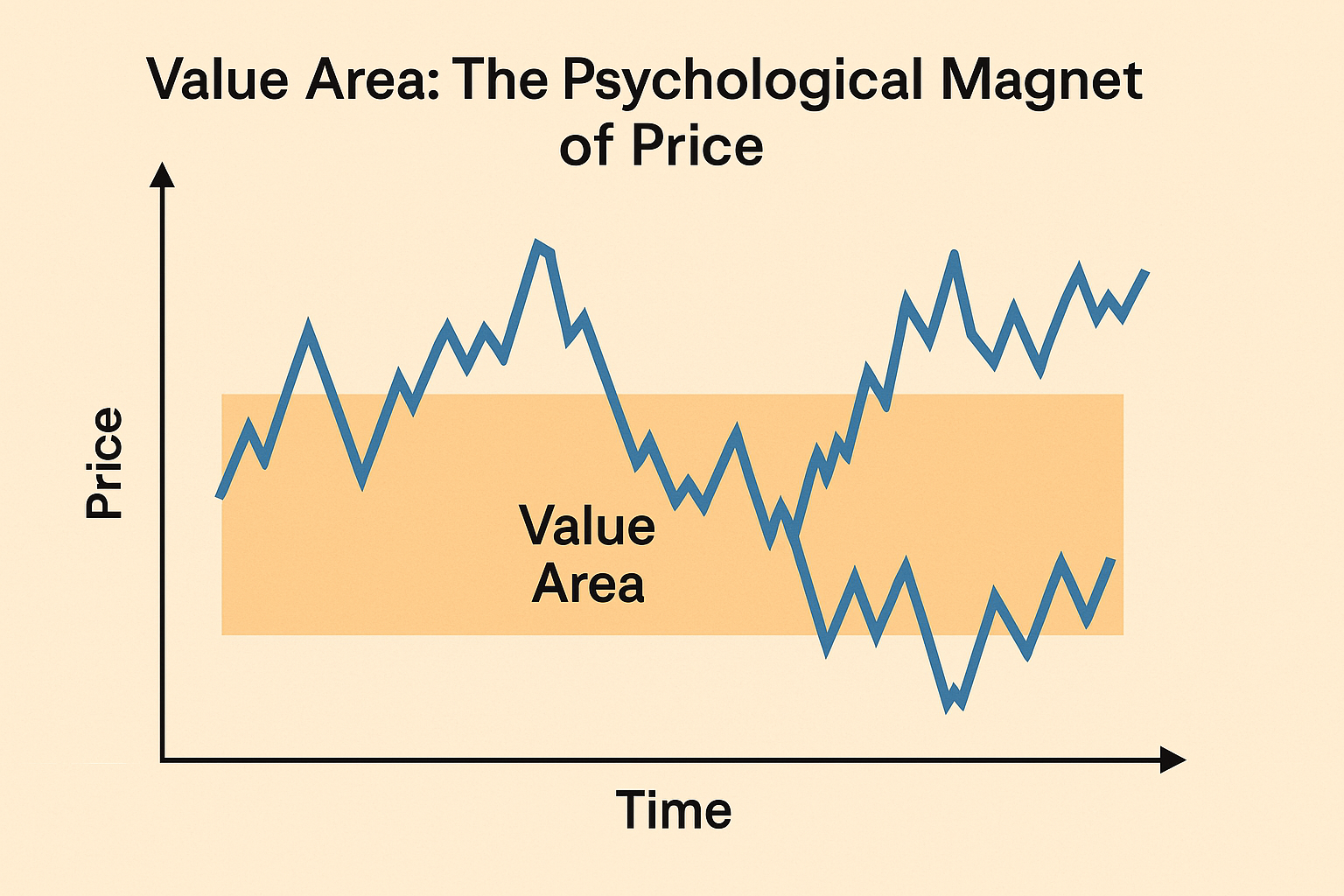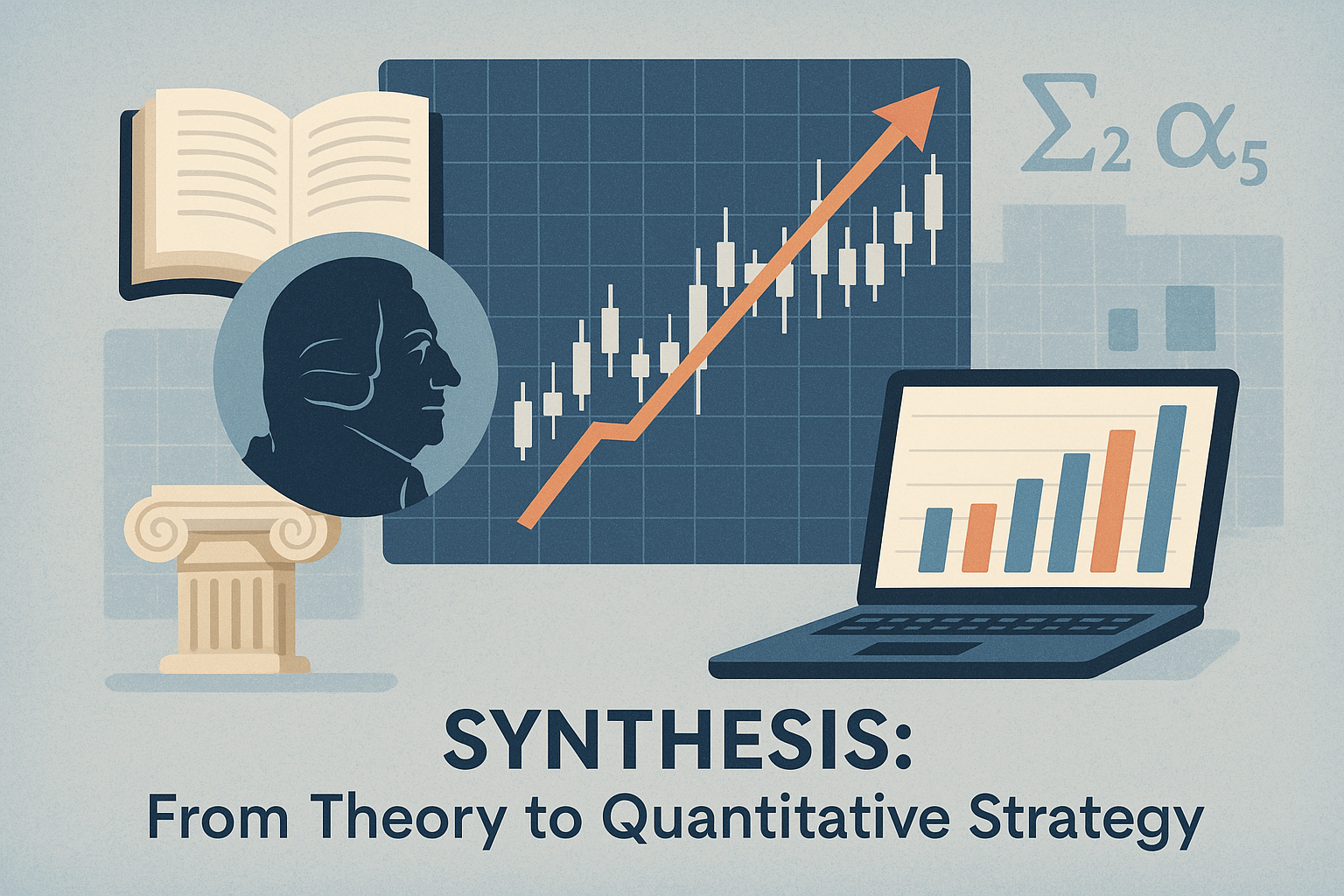Decoding Market's DNA: From Adam Smith to Auction Market and the Value Area

This article examines the intellectual progression from classical economic theory to modern market microstructure analysis, providing a framework for understanding market behavior that goes beyond surface-level technical analysis
Markets Are More Than Just Charts
Markets are often reduced to visual representations candlesticks, indicators, price lines. Yet beneath these moving figures lies a far deeper mechanism: a perpetual negotiation of perceived value. In essence, markets can be seen as dynamic auction houses, where price is not just a number it's a reflection of collective perception of value, and each tick is the result of collective opinion converging temporarily.
This perspective transforms how we analyze market behavior, moving beyond simplistic chart patterns toward understanding the underlying mechanisms that drive price discovery. This concept is not new. It traces back to the foundational work of Adam Smith, whose The Wealth of Nations, published in 1776, introduced the invisible hand as a mechanism of self-regulating systems and laid the foundational understanding of how markets and prices function in a free economy.
Nearly 250 years later, these principles remain relevant, albeit operating at unprecedented speeds and scales. Fast forward to the present, Auction Market Theory offers a framework to interpret real-time market behavior based on that same principle of decentralized decision-making. Meanwhile, the concept of the value area helps traders identify the gravitational zones where markets are most comfortable specific price zones that act as psychological "gravitational centers" where equilibrium is repeatedly sought.
The intellectual arc from classical economic theory to modern market microstructure analysis offers traders and analysts a comprehensive lens through which to build probabilistic models. Understanding markets at this fundamental level is essential for developing robust quantitative strategies that remain effective across various market conditions.
This article explores the intellectual evolution from classical economics to modern auction dynamics, demonstrating why this conceptual framework matters for data-driven trading approaches. By comprehending the forces that shape market behavior, analysts can design more resilient systems that align with, rather than fight against, the natural structure of markets.
Adam Smith and the Foundations of Market Thinking

Classical Value Theory as the Basis of Price Structure
In 1776, Adam Smith published The Wealth of Nations, laying the groundwork for how prices form in a competitive, self-interested marketplace. His economic philosophy established several principles that continue to underpin modern market analysis. His concept of the "invisible hand" proposed that markets naturally optimize resource allocation through the self-interested actions of individual participants. This process occurs without central coordination, creating what appears to be an organized system emerging from decentralized decision making.
The core of Smith's thinking relevant to market analysis includes:
- Subjective value determination: Value is not an inherent property of goods but emerges from human judgments and preferences. The idea that value is not intrinsic, but derived from the perceptions and preferences of individuals.
- Price as information: Prices serve as signals that communicate the relative scarcity and desirability of goods and services. Prices, therefore, are emergent phenomena, determined not by objective cost alone but by the interaction of countless independent judgments about worth.
- Market efficiency through competition: Competitive forces drive prices toward equilibrium levels that reflect aggregate supply and demand.
These classical concepts directly connect to modern market dynamics. Today's electronic exchanges simply accelerate and scale the same fundamental processes Smith described. High-frequency algorithms and institutional order flow still operate according to these principles just at millisecond speeds and global scale. Every bid and ask on an exchange is a statement of belief about value. Even algorithmic orders are built on human encoded assumptions about what assets are "worth."
For quantitative analysts, this historical perspective offers crucial context. Before applying statistical models to price data, one must recognize that prices are not mere numerical sequences but manifestations of complex social and psychological dynamics. Price movements reflect changing perceptions of value rather than changes in any absolute value measure.
This understanding serves as a philosophical foundation for more advanced market structure theories. It explains why purely technical approaches that ignore the behavioral aspects of markets often struggle during regime changes or unusual market conditions. Quantitative analysts who build models without acknowledging these behavioral dynamics risk creating statistical shells numerically precise but conceptually hollow. Before one can measure the market, one must understand the human and collective logic behind it.
Auction Market Theory: When Markets Behave Like Auctions

Micro-Level Psychology of Price Discovery
Auction Market Theory (AMT) represents a significant advancement in understanding market microstructure. This framework, developed and refined by traders and theorists like J. Peter Steidlmayer in the 1980s, conceptualizes markets as continuous two-way auctions rather than static pricing mechanisms. AMT shifts the lens from macroeconomic fundamentals to the microstructure of price discovery. Rather than seeing markets as reflective of intrinsic value, AMT views them as auction environments where prices continuously adjust to match buyers and sellers at each moment.
The theory's central premise is straightforward: markets operate as negotiation platforms where buyers and sellers continuously attempt to find agreement on value. There is no "fixed" or "correct" price only temporary consensuses that shift as new information and participants enter the market. In an auction, there is no "correct" price only the level where opposing forces find temporary agreement.
How Price Discovery Works
Every executed trade represents a momentary agreement on value between at least two market participants. The price at which this agreement occurs provides information about current market perception, but the volume traded at that price indicates the strength of consensus. Higher volume at specific price levels signals stronger agreement among market participants that this represents fair value under current conditions. Every transaction is an opinion, and the more volume traded at a specific level, the greater the implied consensus.
This understanding transforms how we interpret market movements:
- Price changes represent evolving perceptions rather than objective value shifts
- Areas of high trading activity indicate zones of value acceptance
- Rapid price movements through certain levels suggest value rejection
- Failed attempts to move beyond certain prices reveal important psychological barriers
Key Tools in Auction Market Analysis
Several analytical methods have emerged to visualize and quantify auction market behavior:
Volume Profile displays the distribution of trading volume across price levels, identifying where most transaction activity has occurred. This reveals which prices the market has "accepted" as fair value.
Market Profile and Time Price Opportunity (TPO) charts map price activity across time, showing how long the market spent trading at each level. These tools help identify developing value areas and potential breakout zones.
These approaches stand in contrast to time-based charting methods by prioritizing price and volume information over chronological sequence. They reveal the "shape" of market activity rather than just its direction. These tools help traders visualize areas of price acceptance versus rejection, enabling a more nuanced approach to interpreting charts beyond simple indicators.
Application in Quantitative Strategies
Auction Market Theory provides the conceptual foundation for numerous quantitative trading approaches:
- Order flow analysis that tracks the aggression of buyers versus sellers
- Volume Weighted Average Price (VWAP) models that benchmark execution quality
- Liquidity imbalance strategies that identify potential price inefficiencies
- Opening range breakout systems based on initial auction behavior
For quantitative strategists, AMT provides the theoretical justification behind widely used models such as VWAP (Volume Weighted Average Price), liquidity-based execution strategies, and volume imbalance algorithms. It bridges the behavioral origins of value perception with real-time, measurable market actions.
By incorporating auction theory principles, quantitative analysts can develop more nuanced models that account for market microstructure effects often missed by purely statistical approaches.
Value Area: The Psychological Magnet of Price

Navigating Price Through Volume Based Gravity
Among the most actionable concepts derived from Auction Market Theory is the value area. The value area concept represents a refinement of Auction Market Theory, focusing on identifying specific price ranges that exert psychological influence on market behavior. Technically defined as the price range containing approximately 70% of trading volume over a specified period, the value area represents where most market activity has occurred and by extension, where the market has found temporary agreement on fair value.
Definition and Function
The value area concept operates on the premise that markets spend most of their time establishing value rather than discovering new price levels. The standard calculation identifies the prices containing the middle 70% of volume (from the 15th to the 85th percentile of volume distribution), though some analysts use different percentages based on their particular application. This range represents where the market has found fair value where neither buyers nor sellers feel compelled to strongly oppose the price. In other words, it's the market's center of psychological gravity. This zone functions as a reference point for market participants, creating a form of "gravitational pull" on price. The concept applies across timeframes, from intraday to multi-year market cycles, though the stability and significance of the value area typically increases with the timeframe length.
Price Dynamics Around the Value Area
Market behavior relative to the value area often follows predictable patterns:
- Mean reversion within the value area: Prices tend to oscillate within this range as neither buyers nor sellers have sufficient conviction to establish new value levels.
- Rejection at value area boundaries: Initial attempts to break beyond the value area frequently fail as the prior consensus on value reasserts itself.
- Return to value after excursions: When price moves away from the value area and fails to attract volume, it often reverts back, signifying overextension.
- Breakouts with confirmation: When price accepts outside the value area and builds volume, it may signal the beginning of a new equilibrium zone. Sustainable moves beyond the value area typically require increased volume and follow-through, signaling a genuine shift in value perception.
This dynamic underpins many market behaviors traditionally described as mean-reversion or breakout movements. These behaviors create identifiable patterns that inform both discretionary and systematic trading approaches. Price movements away from and back to the value area drive mean-reversion strategies, while confirmed breaks beyond the value area support momentum and trend following systems.
Importance in Strategy Design and Risk Management
The value area concept provides several advantages for quantitative strategy development:
- Objective context: Value areas establish reference points based on actual transaction data rather than arbitrary technical indicators.
- Probabilistic edge identification: Mean-reversion probabilities typically increase as price moves further from the value area without confirmation.
- Risk zone definition: Value area boundaries often serve as natural places for stop-loss or take-profit levels based on market structure.
- Volatility forecasting: Contraction or expansion of the value area over time provides insights into potential future volatility.
From a quantitative perspective, the value area serves as a contextual anchor for models. Entry and exit signals can be filtered based on price's relationship to the value area whether it's approaching, rejecting, or consolidating within it. This filtering enhances statistical reliability by anchoring trades in zones where behavioral stability or instability is measurable.
By incorporating value area analysis, quantitative strategies gain a structural foundation that aligns with market participant behavior rather than relying solely on statistical patterns that may lack causal explanation.
Synthesis: From Theory to Quantitative Strategy

Bridging Economic Philosophy to Market Models
There's a clear intellectual lineage that flows from Adam Smith's invisible hand, through Auction Market Theory, and into modern trading tools like value areas. The intellectual progression from Adam Smith's economic theory to modern market microstructure concepts represents a coherent evolution of understanding. This journey moves from macro behavioral principles to micro price mechanics and finally to actionable trading zones:
- Adam Smith's invisible hand explains how markets efficiently allocate resources through decentralized decision-making and price signals. Macro behavior logic: prices emerge from independent, value-driven decisions.
- Auction Market Theory reveals how this process manifests in real-time bidding and offering behaviors that produce price discovery. Micro price mechanics: prices are continuously negotiated via auction processes.
- Value Area analysis identifies specific price zones where this auction process has established temporary consensus, creating structural reference points. Actionable trade zones: structure emerges where market participants agree most often.
This progression bridges abstract economic philosophy with practical trading applications, providing a comprehensive framework for understanding market behavior across scales and timeframes.
Implications for Model Design
This integrated perspective has profound implications for quantitative strategy development:
Quantitative models built without regard for market structure often capture statistical anomalies rather than persistent behavioral patterns. They may perform well during specific market regimes but fail when conditions change. Conversely, strategies based solely on theoretical market behavior without statistical validation risk being influenced by cognitive biases and narrative fallacies.
For model builders and quants, the implications are clear:
- Quantitative strategies must be rooted in structure, not just statistical anomaly detection.
- Pure data mining without understanding market behavior leads to overfitting and spurious signals.
- Behavioral understanding without systematic modeling leads to bias and inconsistency.
The most robust approach integrates both perspectives:
- Structure without statistics = subjective bias
- Statistics without structure = curve fitting
- Structure with statistics = robust edge
This synthesis suggests quantitative models should incorporate market structure principles while maintaining statistical rigor. Testing should occur both in-sample and out-of-sample, with performance evaluated against structural expectations rather than merely maximizing historical returns.
Examples of Practical Application
Several quantitative approaches successfully integrate these concepts:
VWAP-Based Mean Reversion, Strategies that identify deviation from Volume-Weighted Average Price and trade toward this value benchmark, with position sizing proportional to the degree of deviation from established value.
Value Area Breakout Confirmation, Systems that filter traditional breakout signals based on volume characteristics and value area relationships, entering only when price action demonstrates genuine value migration rather than temporary excursions.
Liquidity Imbalance Models, Approaches that identify significant order imbalances at key structural levels, anticipating price movement as the market resolves these imbalances.
By embedding concepts like value areas into models whether for VWAP reversion, liquidity heatmapping, or adaptive signal filtering traders gain a probabilistic edge grounded in both market logic and historical behavior.
These methods marry the philosophical understanding of markets as auction processes with the statistical rigor of quantitative analysis. They seek to model not just what prices might do next, but why they behave as they do creating more robust and adaptable trading systems.
Conclusion: Analyzing Markets with Two Lenses
Summary and Strategic Outlook
Market analysis is incomplete when viewed through only one lens. Whether visual, statistical, or structural each perspective reveals a piece of the puzzle. But to build systems that endure, both what is happening and why it's happening must be understood.
The evolution from classical value theory to modern market microstructure analysis provides a comprehensive framework for understanding price behavior. Adam Smith's invisible hand still operates, though now at electronic speeds across global networks. Auction Market Theory reveals how this classical framework manifests in continuous two-way negotiations about value. The value area concept identifies where these negotiations have temporarily reached consensus, creating structural reference points that influence future price action.
This understanding requires analysts to employ dual perspectives:
- A behavioral lens that understands why market participants act as they do
- A structural lens that identifies how these behaviors create observable patterns
Neither perspective alone provides a complete picture. The behavioral view without structural understanding leads to narrative driven biases, while structural analysis without behavioral context can miss the causal factors driving market evolution.
For quantitative strategists, this dual approach offers significant advantages. Models built with awareness of market structure tend to be more robust across varying conditions. They align with rather than fight against the natural tendencies of market behavior. Most importantly, they provide explanatory power beyond mere prediction they help analysts understand not just where prices might go, but why they move as they do.
Understanding these connections is not merely academic. It informs execution, strategy, risk management, and model robustness. This deeper understanding serves as a competitive advantage in market analysis. As algorithms increasingly capture straightforward statistical edges, the sustainable advantage comes from comprehending the market's underlying structure its DNA. Whether building automated systems or making discretionary decisions, this integrated perspective helps navigate the complexities of modern markets more effectively.
"Your model may predict where price is going but does it understand why price is moving there?"
That distinction is where real edge begins. The answer to this question often separates strategies that succeed temporarily from those that generate sustainable results across market regimes.